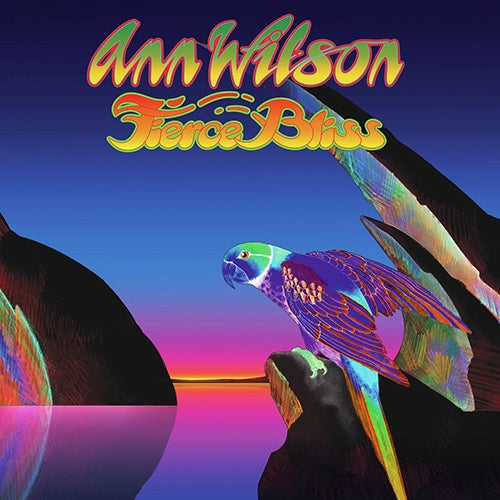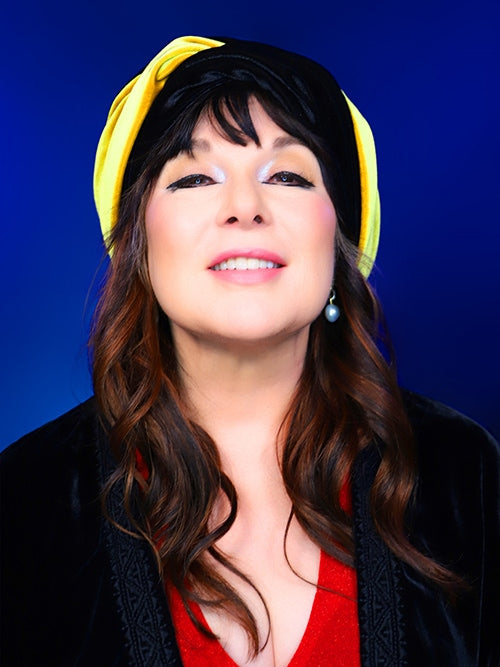It is sometimes rare to find established artists who have something new to say, something new to prove, or some new creative impulse they simply have to share. Ann Wilson seems ready to do it all. After being on top of the music world numerous times with rock legends Heart and a continuing solo career, exploring everything from rock to pop to folk and blues, Ann has found her way back to where it all began – fronting a fiery hot rock band. On April 29 via Silver Lining Music, she will release her latest album, Fierce Bliss, a record rooted firmly in the Seattle rock sound.
The genesis of the record (now available for pre-order) had an interesting beginning. Entertainment attorney Brian Rohan, former lawyer for the Grateful Dead and Ken Kesey among others, began to make some introductions that led Wilson to assemble a group of hot session musicians from Nashville. They all met for the first time at Alabama’s famed Muscle Shoals Sound Studios and cut songs that would find their way to fans via last year’s EP, Sawheat 8 (recorded after her 2018 album Immortal, covered in Issue 135). The chemistry was so strong between Ann and the band that they continued to lay down tracks in Alabama, then in Nashville and later Connecticut. There, guitarist/musicians Kenny Wayne Shepherd and Warren Haynes respectively joined in on the fun and made contributions to the music that add plenty of attitude, wire-to-wire. As powerful as those collaborations are, perhaps the most remarkable addition to the record are the harmony vocals country legend Vince Gill provides on the ballad “Love of My Life.” His sterling, angelic vocals cradle Ann’s powerful rock rasp in a way that surprises and delights.
The album is being released on vinyl in addition to CD the usual streaming services, so Ann and company took great care in the packaging design, paying close attention to every detail. That began with the cover art by Roger Dean. Best-known for his work with bands like Yes and Asia, Dean developed a cover image that appropriately captures the sense of survival and hope represented in each of the record’s 11 tracks. While the album’s packaging and presentation provide a lot of material to pore over while the record spins, it will be difficult to take attention away from Ann Wilson’s voice, which is remarkably strong, with a clarity and confidence that is as present as it was on the 1975 Heart debut album, Dreamboat Annie.
Ann is currently back on the road in support of her “An Evening With Ann Wilson of Heart and The Amazing Dawgs” tour. We caught up with her to talk about the making of this “fierce” new record, the influence that her band and guest artists have had on her creative process, and how at this point in her life there is a peace and serenity that have given her great balance, but that haven’t tamed her rock and roll heart or passion for making music and performing live.

Ray Chelstowski: Fierce Bliss comes out right on the heels of last year’s EP, Sawheat 8. Were these songs recorded during those sessions?
Ann Wilson: Yes. Suddenly, I had a bunch of songs that I wanted to record. We started with the ones [we’d recorded] at Muscle Shoals and then just kept going. We went to Sound Stage Studios in Nashville and then to Power Station New England in Connecticut and got them all done. We got cover art from Roger Dean and were on our way.
RC: The single, “Greed,” sounds like it could have been a 1970s Heart track and sets the tone for the whole record. Was it the first song you recorded?
AW: I think the first ones we did were “Fightin’ For Life” and “As the World Turns.” My guitarist, Tom Bukovac and I hadn’t written “Greed” at that point. We wrote that during the second session at Sound Stage in Nashville. But it was in that first Muscle Shoals session that I began to understand that this was the band that I wanted to be in and work with. They can do anything. They can do Heart, they can do the Rolling Stones; they can be anyone you ask them to be. Most importantly, they can make it really rock. That’s what that first session was really all about.
RC: It shows. This lineup really adds a terrific amount of muscle to every track.
AW: Yeah, I agree. After all of the quarantine there was a lot of pent-up energy for everyone. Our attitude was, “let’s rock!”
RC: Was this band hand-picked or had they worked together before as a backing outfit?
AW: Well, we assembled the band. But I knew that [they] all had known of each other before this, and some had been together on projects before. But they had never all been together before as a band. They’d played a lot of sessions for other people where they had gone in and had people tell them what to play. But with this band I don’t tell them what to play. They bring their own thing to it. That’s what makes it so good. It’s got Tom’s brainy brilliance and Tony’s (Lucido, bass) muscle. The drummer, Sean T. Lane, is from Seattle and he was just like a stranger that came into the mix. He’s just amazing and also so cool. And of course, there’s – Gordon Mote, our keyboard player, who also [plays] guitar and mandolin. It’s just a really cool band that frankly has everything that I need.
RC: You have always used video to support the release of new material, whether it’s a single, an EP or a full-length album. For many established artists that seems to becoming rarer.
AW: Maybe that was something that [started happening to me during the 1980s MTV period. But I really think that if it’s the right video for a song, then it can’t be beat. It’s just a real nice combo. It’s like opening up another room to help you better understand the song. The video for “Greed” was done by an art student. We told him to just run with it and to show us what she could do. I think this kid, Elliot Crotteau, did a really great job.
RC: One of the great surprises of the album is to see and hear Vince GilI appear on the song “Love Of My Life.” I would have never thought that his voice would match so well to yours. How did that come about?
AW: I wanted to do a duet with a man on that one. I thought long and hard about what it should sound like, because the tone of the man’s voice was going to dictate everything in the song. So, it couldn’t be someone with a gruff or smoky voice. It had to be an angel! I’ve always been a massive fan of Vince. Whenever I hear him sing I just go, “please!” It’s just so beautiful. I was so surprised when he accepted. He just got in the car one night and drove down to Muscle Shoals from Nashville. He was by himself, came in and sang, then drove back. He was just so unassuming, and great!
RC: What many people don’t know is how accomplished Vince is on guitar. Years ago, he was actually recruited by Mark Knopfler to join the band Dire Straits!
AW: Yeah, you don’t think about Vince’s guitar playing that often. That was actually the first thing that I ever heard him do. Back in the day, Heart was on a bill with Rush and Pure Prairie League. Vince was in Pure Prairie at that time and I witnessed him play during a sound check in the afternoon. The band was playing Led Zeppelin songs. He was just peeling them out, totally at home with every genre. I thought, “what a player”! Then he opened his mouth to sing!
RC: I interviewed Warren Haynes a few months back and he raved about The Power Station in Connecticut. You cut a few tracks with him and Gov’t Mule there. What did you think of the studio?
AW: It came time for when I needed to get Warren and Gov’t Mule on tape for my record. It just so happened that simultaneously they were [at the studio] working on two albums. One was just a regular Mule record and the other one was all blues. They took over two rooms at The Power Station. One was set up for the blues record, and one was set up for the other one. So, I just went in and became the lead singer for the two songs that Warren and I wrote together for my record. I thought it was a really cool place.
RC: You recorded the album in three separate locations, with a number of guest musicians and yet the record really holds together like it was all cut in one studio.
AW: That was helped a lot by the guy who mixed the record, Chuck Ainlay. He just made everything live together nicely on the same record.
RC: Another surprise on this record are the covers you chose, especially Robin Trower’s “Bridge of Sighs.” The original has a David Gilmour vibe to it, where yours really comes alive and kicks into gear with the addition of Kenny Wayne Shepherd.
AW: When we were discussing “Bridge of Sighs,” Kenny Wayne got really excited. I think that’s because he’s younger and the Robin Trower track was something that he was probably raised on. So, when we discussed doing it his eyes just lit up. He came into the studio and just tore the lid off of the song.
RC: Roger Dean did the cover art and of course is best known for the album images he created for bands like Yes and Asia. How did you decide that he was the right artist for this project?
AW: We are releasing the album on vinyl and I just want people to have the full vinyl experience. We have a really warm-sounding, loud record and now you have something to hold in your hands while you’re listening. There’s so much to check out in the packaging. There a booklet and a bunch of photos and all of the lyrics. It’s a beautiful package and Roger Dean and his team put it all together.
RC: The record thematically seems to have a survivor’s perspective. Is that intentional?
AW: Definitely. The pandemic and the quarantine just made for a lot of thinking and daydreaming space. That’s where those songs come from. They just materialized through this period.
RC: You have a bunch of tour dates lined up, mostly on the West Coast. Beyond that, what lies ahead?
AW: I think that I just want to keep writing. In fact, I’m writing for another new album right now. Fierce Bliss comes out April 29 and by that time I’ll have three or four songs finished for another album. I’m just gonna keep on going.
Header image courtesy of Ann Wilson.



